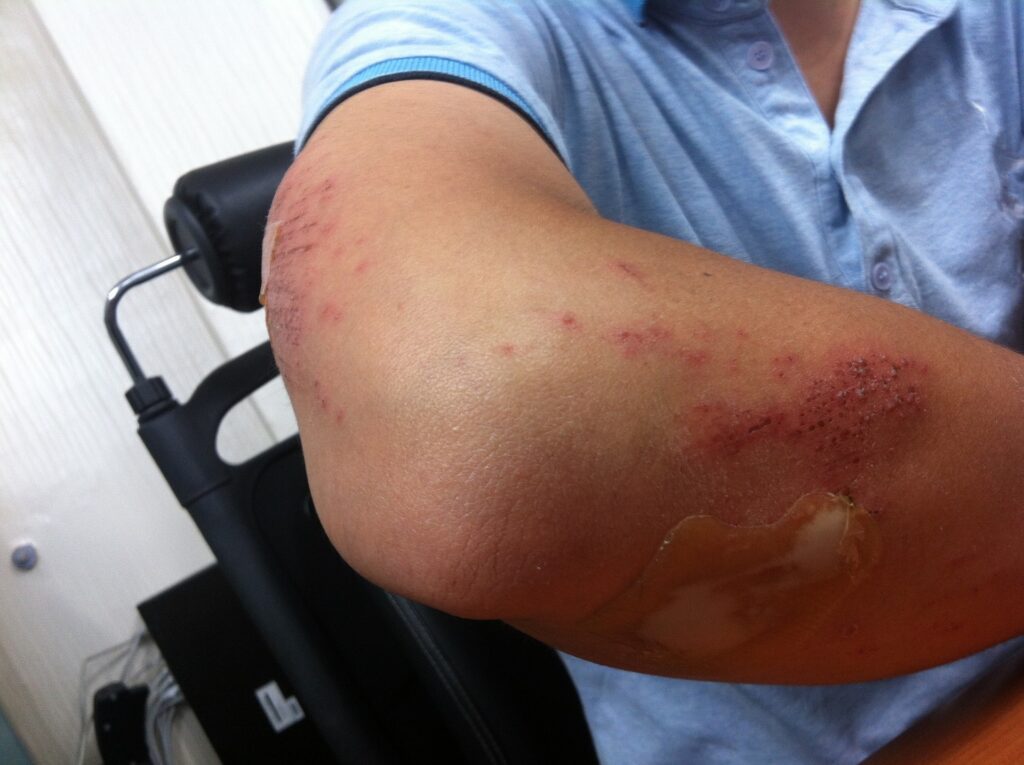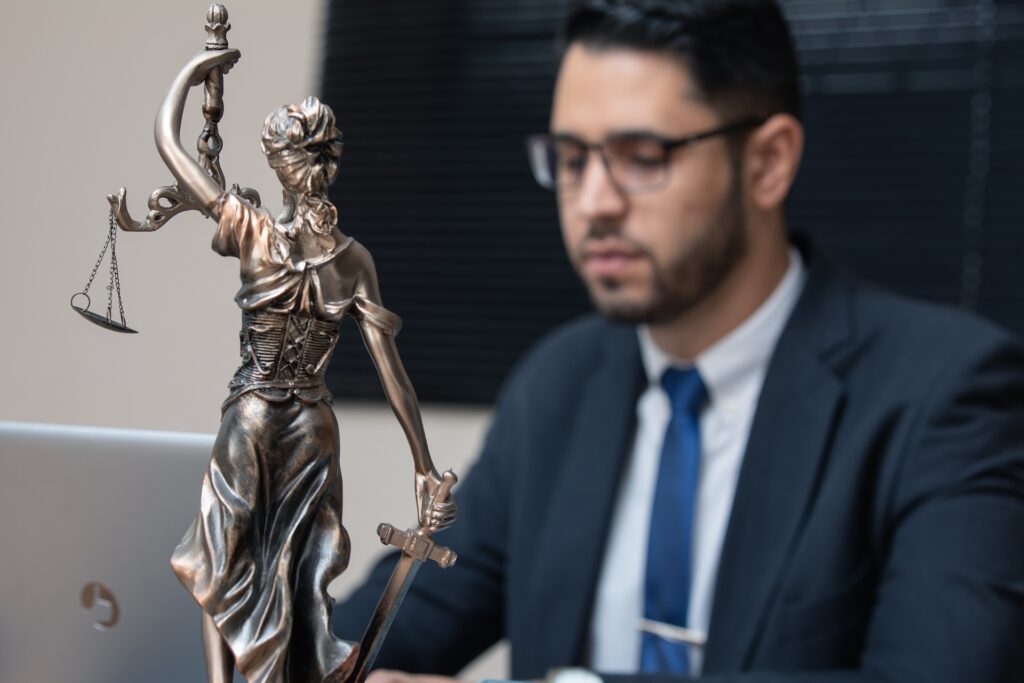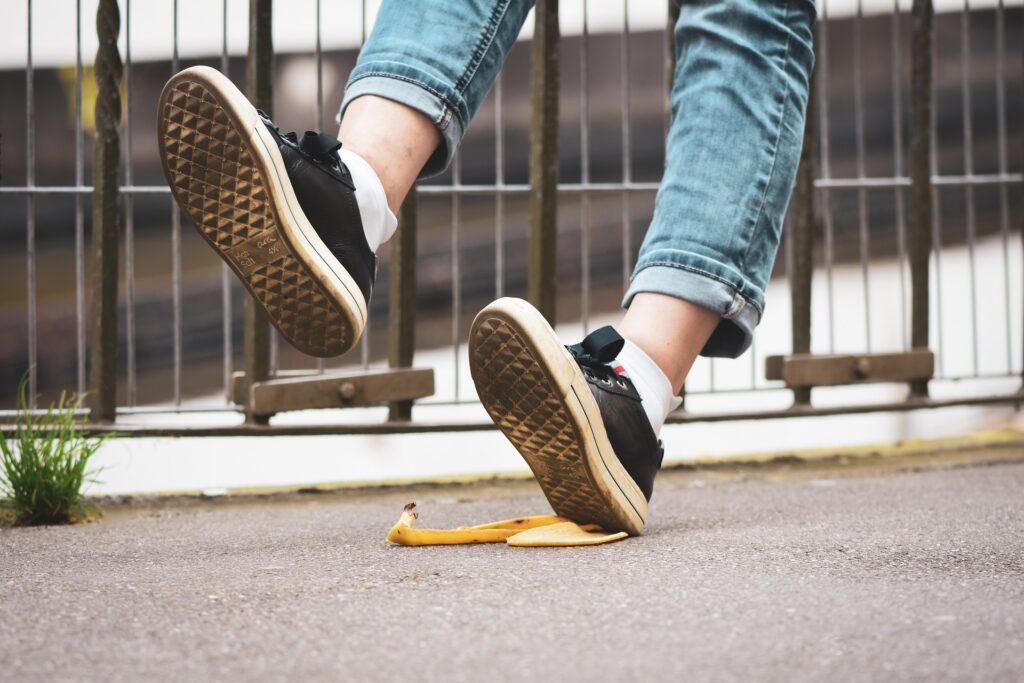Any place can be at risk for slips, trips, and falls. But certain areas and industries are more prone to these accidents. In 2021, 46.2 percent of fatal slips, trips, and falls were associated with the construction industry.
Regardless of where it may happen, accidents involving slips, trips, and falls can result in severe injuries and substantial financial burdens. Suppose you sustained slip, trip, and fall injuries due to another person’s negligent actions. You may obtain compensation for your losses, including pain, medical treatment, and missed time at work.
However, you must first understand the difference between a slip and fall accident and a trip and fall accident to ensure a successful injury claim. Although others use these terms interchangeably, they have slightly varied hazards and causes, which can affect the nature of your claim.
For instance, the presence of a substance on the floor often causes an individual to slip and fall. In contrast, when someone trips and falls, the reason is likely they stepped on a fixed hazardous object. Understanding these distinctions is crucial in explaining how you were injured and establishing liability for them.
In the following sections, we’ll discuss how a trip and fall injury claim works and what you can do to secure fair compensation.
Key Takeaways
|
What is a trip and fall accident, and how does it occur?
A trip-and-fall accident usually happens when there’s an object lying on the ground rather than a substance. In many cases, the victim may be unaware of the obstacle or misjudge their steps to avoid the tripping hazard.
When that happens, a person’s foot will likely hit the unexpected obstruction in their path. Consequently, the body’s center of gravity shifts forward, causing the victim to lose balance and fall while their feet remain stuck.
Trips and falls frequently occur in outdoor settings like parking lots with potholes and uneven sidewalks. These types of accidents may also happen in a grocery store with uneven surfaces and insufficient lighting.
Poor housekeeping, such as cluttered mops, wrinkled carpeting, and other debris on the floor, can also result in a trip-and-fall accident. Any tripping hazards can cause significant harm to anyone visiting the property.
Possible Injuries From a Trip and Fall Accident


Trips and falls often cause victims to fall forward instead of backward. In the case of a backward fall, you may struggle to move your foot forward fast enough to regain your balance.
As you trip and fall forward, your natural response is to throw your hands out to stop the fall. Consequently, various parts of your body will come into contact with the ground and sustain the following types of injuries:
Soft-tissue injuries
You may attempt to stop the fall by extending your arms when you trip and fall forward. The impact force can cause a minor sprain or complete tear to your soft tissues, including the muscles, ligaments, and tendons.
Some soft-tissue injuries may heal on their own with rest. But more severe injuries may need surgical repair and years of physical therapy. Some victims may suffer from chronic pain and not recover full mobility after the healing phases.
Broken bones
It’s common to experience broken bones after absorbing the shock of tripping and falling. Extending your hands can help reduce the impact on the rest of your body. But your fingers, wrists, and arms will likely suffer from broken bones or fractures.
In more serious cases, the impact of the fall can also result in broken hips or pelvis. These types of trip and fall injuries require surgery most of the time. It can also permanently affect an individual’s mobility and overall quality of life.
Shoulder and neck injuries
In a trip and fall accident, your shoulder and neck bear the most impact as you land on the ground. Injuries to the shoulder may involve dislocation, nerve tears, or collarbone breaks. On the other hand, neck injuries resulting from tripping and falling can range from minor muscle sprains to spinal cord injuries. More severe injuries to the neck and shoulder may lead to complete paralysis.
Traumatic brain injuries
Tripping and falling can also put your head at serious risk of hitting the ground or an object. The violent force and movement on the head during a fall can cause your brain to shake inside your skull.
This forceful impact can lead to various traumatic brain injuries (TBIs), ranging from mild concussions to skull fractures and hematomas. Depending on the impact force, a traumatic brain injury can leave you with permanent physical and cognitive impairments.
Understanding the nature of your trip and fall injuries is crucial when determining the treatment you need and the compensation you can recover.
Understanding Premises Liability in Trip and Fall Accidents
Under premises liability, property owners can be held legally responsible for accidents and injuries caused by unsafe conditions on their residential or business premises. Trips and falls are frequent types of accidents that may fall under premises liability.
However, merely tripping and falling on someone else’s property doesn’t make the owner automatically liable for the injuries you suffered. There are certain conditions that must be met for you to recover damages under premises liability in a trip and fall accident.
States may have different laws regarding premises liability. It’s important to understand what the law in your state requires before pursuing an injury claim. But generally, all states may share these grounds for a premises liability case.
How can you prove negligence in premises liability?
Like other personal injury cases, you must prove negligence to hold property owners legally responsible for trip and fall accidents on their premises. You can do that by establishing the following elements of negligence:
Duty of care
Generally, property owners have a legal duty to take reasonable caution to keep foreseeable harm from happening to anyone entering their premises. However, this obligation may only apply to visitors with a lawful right to be on the property.
Suppose you’re a trespasser. The owner may only owe you a duty of care under specific circumstances. For instance, owners must provide adequate warning signs if their property has attractive nuisances, such as pools and tree houses. The reason is to prevent causing harm to trespassers, specifically children.
Breach of duty
The second essential element of negligence is proving that the property owner breached their duty of care. That is, they failed to meet their legal responsibility to keep their premises reasonably safe. When establishing a breach of duty, you must prove the following:
- The owner knows about the existing dangerous conditions on the premises.
- The owner could have prevented trip and fall accidents from happening.
- The owner didn’t provide a warning or address the tripping hazard within a reasonable timeframe.
Causation and proof injuries
It’s typical for an
Who are the potentially responsible parties in a trip and fall?
Although the property owner is primarily responsible, multiple parties may share liability for the accident. Here are the potentially responsible parties in a trip and fall accident:
- Residential property owners: If you get injured from tripping and falling on a residential property, you can hold the homeowner liable for your injuries. But they can only be responsible if an existing tripping hazard causes the accident.
- Business owners: If a trip and fall accident happens in a restaurant, store, or any place of business, the owner can be held responsible for the resulting harm. But you must provide sufficient proof the accident occurred because they failed to take the necessary preventive measures.
- Government: You can also hold the local, state, or federal government liable for your injuries if the trip and fall accident happened on government property. But government entities may have immunity provisions related to premises liability. This immunity makes the process and requirements more complex than the usual trip and fall claims involving private property owners.
What are the different types of compensation?
Financial compensation available in a trip and fall accidents typically falls into the following categories:
- Special damages: These damages aim to reimburse you for your economic losses. Special damages may include medical bills, past and future income you lost while recovering, and other accident-related out-of-pocket expenses.
- General damages: These damages intend to compensate you for your non-economic losses or the impact of the injuries on your quality of life. General damages may consist of physical pain and suffering, emotional distress, and loss of enjoyment of life.
- Punitive damages: Instead of compensating you for your losses, these damages seek to punish the reckless behavior of the liable party and deter similar conduct in the future. But punitive damages in premise liability cases are rare. It requires proving the property owner’s behavior constitutes gross negligence and caused you catastrophic harm.
How To Obtain Maximum Compensation for a Trip and Fall Injury Claim


The amount of compensation in a trip and fall accident can vary, depending on the details of the accident. Although no exact formula determines how much you can expect to receive, you can take proactive steps to maximize your compensation.
Here are crucial actions you should take after getting involved in a trip and fall accident:
Seek immediate medical attention
Regardless of whether or not you feel any pain, you must seek immediate medical attention after a trip and fall accident. A doctor’s examination can reveal injuries that may not be immediately apparent.
Moreover, determining whether you sustain any injuries is essential for your health, as well as your injury claim. For instance, seeking appropriate medical treatment can help establish a direct connection between the accident and your injuries.
Insurance companies may use the gap in treatment to reduce or deny your compensation. But with medical records serving as evidence you visited the emergency room or your doctor, you can safeguard your right to claim compensation.
Report the trip and fall accident
Besides getting the proper medical care, you must also report your trip and fall accident. Having an official record of when and how your trip and fall happened and its causes is crucial.
If you trip and fall in a place of business, the owner or supervisor may provide you with a standardized accident report to complete. Without a report,
Secure the best possible evidence
The quantity and quality of evidence you gather can significantly affect your compensation. Note that
- Photos of the accident scene
- Testimonies of witnesses
- Receipts of medical treatments and other expenses
- Notes and treatment plan from your physician
- Documentation of your injuries and recovery
- Employment records
Contact a personal injury attorney
Although not always required, hiring a personal injury attorney is beneficial to protect your rights and maximize your compensation. A lawyer knows the intricacies of the law and can better establish the liability of the premises owner. They also possess the expertise to evaluate the worth of your claim. Moreover, they can determine the best evidence to use when negotiating with the insurer for the highest possible settlement.
Did you know?
Falls are one of the leading causes of unintentional injury-related fatalities. According to the National Safety Council, falls resulted in the deaths of 42,114 individuals in homes and workplaces.
Seek Legal Help for Your Trip and Fall Accident Case
Did the property owner’s negligence caused your trip and fall injuries? You can seek reimbursement for your medical expenses, pain and suffering, and other losses. However, not every trip and fall victim can hold the premises owner liable for all accidents on the property.
One reason is not all property conditions will make the owner legally responsible for the incident and injuries you sustained. You will need sufficient proof to demonstrate the owner of the premises acted negligently and caused you harm.
To ensure maximum compensation for your trip and fall claim, it’s in your best interest to seek legal help soon after your fall injury. Need help finding a reliable attorney? Obtain a free consultation at The Personal Injury Center, and we’ll put you in touch with a competent lawyer.
Protect your rights after a trip and fall accident. Visit The Personal Injury Center for competent legal advice and assistance.
FAQs on Trip and Fall Injuries
What are the three types of visitors to the premises?
Property owners have different degrees of legal obligations to visitors, depending on their legal status. The status of the person visiting the property refers to their relationship with the owner. In a premises liability case, the following are the three types of visitors:
- Invitees: These guests have express or implied consent to be on the property, mainly for business purposes and transactions. They may include a customer or a delivery worker in a grocery store.
- Licensees: Like invitees, these visitors have permission to enter the premises. However, they are on the property for social or personal reasons. Examples are a guest visiting a friend's home, contractors, or salespeople in a store.
- Trespassers: This visitor category has no permission or legal right to enter a particular property.
How much can you expect from a trip and fall settlement?
The settlement amount for a trip and fall accident depends on the injury's severity, medical treatment costs, loss of income, and other factors. But many trip and fall cases settle between $10,000 and $50,000.
Besides trip and fall accidents, what other situations commonly give rise to premises liability?
Premises liability covers a variety of incidents. Besides trip and fall accidents, the following situations may also lead to a premises liability case:
- Dog bites and animal attacks
- Negligent security
- Escalator accidents
- Fire accidents
- Lead poisoning



